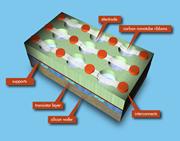 Strings of nanotubes (grey) lie between connectors (red), and bend downwards onto the electronics below (blue) when a current is applied.© Nantero
Strings of nanotubes (grey) lie between connectors (red), and bend downwards onto the electronics below (blue) when a current is applied.© NanteroWill computers that require no time to boot up become a reality? One company thinks the answer is yes, thanks to its carbon nanotube memory chips.
Nantero presented its achievement at the Emerging Technologies Conference in Cambridge, Massachusetts. It uses rolled-up tubes of carbon to make transistors, the on-off switches that carry digital information inside computing chips: strings of the nanotubes move up and down to represent the ones and zeroes of binary code. Unlike the electrons in normal electrical transistors, these nanotubes stay in place even when a computer is turned off.
Nantero, based in Woburn, Massachusetts, has been working on the idea for years. Now they say they have made ground in the manufacturing process, pushing the chips closer to market.
The company has succeeded in making circular wafers, 13 centimetres in diameter, that hold 10 gigabits of data. These much bigger than equivalent memory cards used today. But Greg Schmergel, chief executive officer of Nantero, says the nanotube chips are ten times faster than 'flash' cards, which are some of the swiftest ones now available.
Remember this
Nantero calls its technology NRAM, which is loosely short for nanotube-based, non-volatile random access memory.
Non-volatile components, which by definition keep all data even when the power is turned off, are currently on the market in the form of flash memory cards. These hold electrons in insulated cells to act as ones and zeroes. They can be found in many portable gadgets, from MP3 players to digital camera memory cards.
And ferromagnetic RAM (FRAM) technology shows promise for making faster non-volatile components: it uses the orientation of crystal atoms to store data.
But both flash and FRAM chips wear out over time and lose the ability to store information. FRAM chips, adds Schmergel, cannot be made as small as NRAM ones.
Schmergel says that his chips could come in handy on space ships. The radiation in outer space can interfere with the electrons that store data in flash memory devices, so they have to be protected by lead. NRAM avoids this problem, providing the same computing power with much less bulk to loft into orbit.
Making chips
The design involves suspending nanotube ribbons between points above a silicon chip, so that they form tiny bridges over electrodes lying below. When a charge is applied, the nanotube bridge curves downwards to touch the electrode. This deformation of the nanotube bridge remains even when the power is turned off.
ADVERTISEMENT
Schmergel says that his firm is currently working with manufacturers such as LSI Logic. These companies have swapped some steps in the production of ordinary transistors for laptop computers for steps that make nanotube chips instead.
Norman Armour, vice-president and general manager of the LSI factory in Gresham, Oregon, says developers are "working aggressively" to put the technology to use in electronic devices. He says they still have to check that the chips can be reliably produced on a large scale, but he expects prototypes of products with NRAM to be ready by the summer of 2006.
